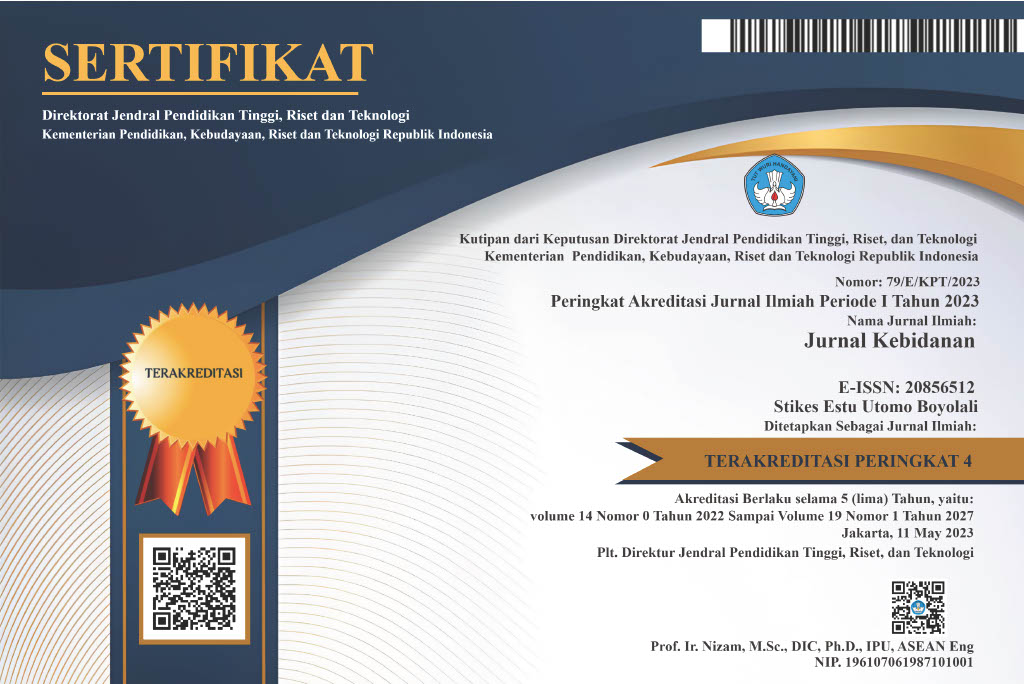-
Lina Puspitasari
Prodi D3 Kebidanan Akademi Kebidanan Graha Mandiri Cilacap
Abstract
ABSTRAKNyeri persalinan merupakan suatu yang tidak bisa dipisahkan dari proses persalinan. Hal ini terjadi akibat peningkatan kontraksi uterus yang membuat janin turun memasuki ruang pelvis dan terus meningkat sampai dengan pembukaan serviks lengkap. Nyeri yang tidak ditangani segera dalam waktu lama dapat mengakibatkan kelelahan pada ibu dan stres yang meningkat dapat mengakibatkan rasa sakit yang semakin kuat dan berdampak pada persalinan lama Tujuan penelitian ini adalah untuk mengetahui efektifitas teknik effleurage dan counter pressure vertebra sacralis terhadap penurunan nyeri persalinan Kala I. Metode penelitian ini adalah eksperimen semu jenis one group without control design. Populasi penelitian sebanyak 142 ibu bersalin selama 3 bulan. Teknik pengambilan sampel dengan cara purposive sampling sebanyak 30 responden. Teknik Effleurage dan Counter Pressure Vertebra Sacralis diberikan kepada pasien oleh peneliti bersama dengan satu bidan sebagai enumerator secara bergantian dengan lama masing-masing 30 menit. Nyeri diukur dengan menggunakan lembar skala nyeri sebelum (pre test) dan sesudah tindakan (post test) oleh peneliti. Efek dari perlakukan terhadap nyeri persalinan dianalisis menggunakan Paired T-test dengan SPSS analisis pre post test. Hasil analisis data diperoleh nilai mean intesitas nyeri sebelum dan sesudah perlakuan, responden mengalami penurunan menjadi (1.45). Hasil uji one sample T-test menunjukkan bahwa keknik Effleurage dan Counter Pressure Vertebra Sacralis efektif menurunkan nyeri pada kala I persalinan dengan nilai sig 0.001 (t-hitung 11.22). Simpulan teknik effleurage dan counter pressure vertebra sacralis terbukti berdampak terhadap pengurangan nyeri persalinan Kala I. Diharapkan ada penelitian lebih lanjut terkait faktor-faktor yang mempengaruhi nyeri persalinan kala I sehingga dapat meningkatkan kualitas asuhan kebidanan. Kata kunci : Effleurage, Pressure, Sacralis, Nyeri, Persalinan EFFECTIVENESS OF TECHNIQUE OF EFFLEURAGE AND COUNTER PRESSURE VERTEBRA SACRALIS TO DECREASED LABOR PAINSABSTRACTLabor pain is an inseparable process of childbirth. This occurs due to an increase in uterine contractions that make the fetus fall into the pelvic chamber and continue to increase up to complete cervical opening. Pain that is not treated immediately for a long time can lead to fatigue in the mother and increased stress can lead to stronger pain and impact on old Labor The purpose of this research is to find out the effectiveness of the technique of effleurage and counter pressure vertebrae sacralis to decreased labor pain The study population of 142 maternity mothers for 3 months. The sampling technique by purposive sampling as many as 30 respondents. The Effleurage and Counter Pressure vertebrae Sacralis techniques are administered to patients by researchers along with one midwives as an enumerator alternately with a length of 30 minutes each. Pain is measured using the pain scale before (pre test) and after the action (post test) by the researcher. The effects of the treat against labor pains were analyzed using the Paired T-test with SPSS pre post test analysis. Data analysis results obtained the value of pain varying before and after treatment, the respondent decreased into (1.45). The T-Test one sample test results showed that the Effleurage and Counter Pressure Vertebra Sacralis were effective in reducing the pain at the time I was delivery with a value of sig 0.001 (T-count 11.22). The technique of effleurage and counter pressure vertebrae sacralis proved to affect the reduction of childbirth pain Kala I. It is hoped that more research is related to the factors that affect labor pain so that it can improve the quality of obstetric care. Keywords: Effleurage, Pressure, Sacralis, pain, childbirth







.png)










